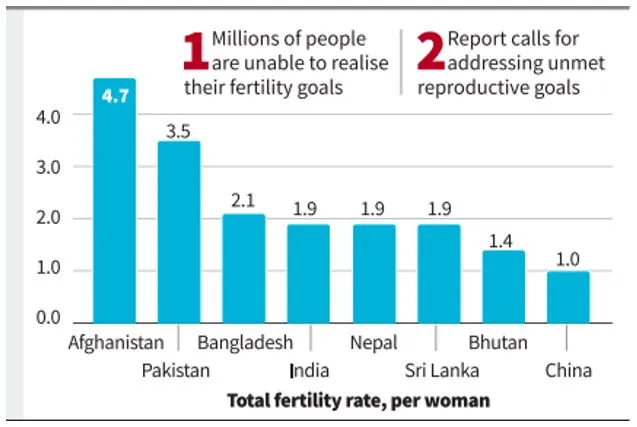

11th June 2025 (9 Topics)
Mains Issues
Context
According to the United Nations Population Fund (UNFPA) State of the World Population 2025 Report, India’s population is estimated at 146.39 crore, with its Total Fertility Rate (TFR) declining to 1.9, below the replacement level of 2.1. The report projects India’s population to peak at 170 crore in the next 40 years, after which it is expected to decline.
India’s Demographic Trajectory and Socio-Economic Implications
India’s Population – Key Statistics
- Current Population (2025, UNFPA):39 crore (India), 141.61 crore (China)
- Fertility Rate (TFR):9 (Below replacement level of 2.1)
- Peak Projection: Population expected to reach 170 crore before declining in 40 years
- Working-age Population (15-64 years): 68% of total
- Youth Demographics (2025):
- Age 0–14: 24%
- Age 10–19: 17%
- Age 10–24: 26%
- Elderly Population (65+): 7%, projected to rise due to improved life expectancy
- Life Expectancy (2025):
- Men: 71 years
- Women: 74 years

Fertility Trends and the “Real” Fertility Crisis
- TFR at 1.9 reflects a shift towards smaller families and delayed childbirth.
- Replacement Level TFR is required to keep population size stable over generations (2.1).
- The UNFPA report calls attention to unmet fertility desires, labelling the mismatch between desired and actual childbearing as the "real fertility crisis."
- Advocates reproductive agency: free and informed choices about sex, contraception, and parenthood.
Implications of Falling Fertility Rates
- Demographic Dividend: With 68% of population in the working-age group, India is positioned to leverage this for economic growth.
- Ageing Population: The elderly population is projected to increase, demanding investment in geriatric care, pensions, and healthcare infrastructure.
- Urbanization & Migration: Urban areas may face increased pressure due to continued population growth in certain pockets, despite national fertility decline.
- Labour Force Dynamics: Lower fertility may eventually lead to a shrinking labour force, especially in states like Kerala, Tamil Nadu, and Delhi, which already have TFRs below 1.8.
Challenges with Delayed Census (2021–2027)
- The Census 2021, postponed to March 2027, results in a data vacuum.
- Accurate demographic policy formulation, welfare targeting, and health service delivery become difficult without decennial census data.
- Increased reliance on surveys and projections (like SRS, NFHS), which, although reliable, are no substitute for comprehensive enumeration.
Way Forward
- Strengthen Data Collection Mechanisms: Interim surveys like SRS, NFHS, and leveraging Aadhaar-linked service data can bridge the information gap until the next Census.
- Policy Shift from Population Control to Population Management: Focus should now be on healthy ageing, skilling of youth, gender equality, and urban infrastructure development.
- Support Reproductive Choices: Ensure access to quality contraception, maternal health, and comprehensive sexuality education.
- Promote Balanced Regional Development: Address regional disparities in fertility through targeted schemes like Mission Parivar Vikas in high TFR states.
Key Terms:Total Fertility Rate (TFR)
Demographic Dividend
Reproductive Agency
|


Mains Issues
Context
The Madras High Court has directed the Union Ministry of Education to consider delinking ?200 crore meant for RTE reimbursements from the larger ?2,151.59 crore pending under the Samagra Shiksha Scheme for Tamil Nadu. The directive comes amid the State's refusal to implement NEP 2020 and its impact on central fund flow.
Funding RTE Obligations Must Be Delinked from NEP Compliance: Madras HC
1. Judicial Background and Directive- High Court Intervention:
- The Madras High Court disposed of a Public Interest Litigation (PIL) demanding timely commencement of RTE admissions for the 2025–26 academic year.
- Directed the Union government to “consider” releasing the RTE reimbursement component (~?200 crore) separately from the SSS allocation.
- Legal Standpoint:
- The Court clarified that non-adoption of NEP 2020 cannot be a reason to withhold funds meant for statutory obligations under RTE Act, 2009.
- Central Funds Pending:
- ?2,151.59 crore is the amount pending from the Centre to Tamil Nadu under Samagra Shiksha Scheme.
- Out of this, ?200 crore pertains specifically to RTE reimbursements to private schools for admissions under Section 12(1)(c) of the RTE Act.
- Section 7 of the RTE Act, 2009:
- Imposes concurrent responsibility on both the Centre and State to provide financial support for implementing RTE provisions.
- Hence, the funding obligation exists independent of policy convergence (e.g., NEP 2020).
- Tamil Nadu’s Position:
- Tamil Nadu has formally rejected the NEP 2020, arguing that it undermines the federal spirit and promotes imposition of Hindi.
- Filed a civil suit in the Supreme Court for release of pending SSS funds.
- Centre’s Stand:
- SSS funds are being withheld partially, allegedly due to non-compliance with NEP provisions.
- High Court Observation:
- The Tamil Nadu government cannot cite “non-receipt of funds” as an excuse to avoid its independent statutory responsibility under RTE.
- Directed to immediately commence RTE admissions and ensure timely reimbursement to private unaided schools.
- Precedents Cited:
- Court referenced existing judicial precedents that reinforce State obligation to reimburse private schools under Section 12(1)(c).
Way Forward:
- Separate Fund Allocation for RTE: Union Ministry of Education should establish a dedicated and protected mechanism for RTE reimbursements.
- Reinforcing Cooperative Federalism: Dialogue-based resolution rather than financial coercion should guide Centre-State education funding relations.
- Early Judicial Resolution: Supreme Court must expedite hearing on Tamil Nadu’s civil suit to avoid prolonged uncertainty in education service delivery.
- Strengthening Monitoring Mechanisms: Independent audits and disaggregated fund flow tracking under Samagra Shiksha to ensure RTE mandates are not compromised.
Samagra Shiksha Scheme (SSS)
Right of Children to Free and Compulsory Education (RTE) Act, 2009
National Education Policy (NEP) 2020
|


Mains Issues
Context
Türkiye has been expanding its strategic presence across West Asia, North Africa, and the Caucasus, driven by an assertive foreign policy under President Recep Tayyip Erdogan. The rise of Islamist regimes and Türkiye’s calibrated role in conflicts like Syria and Azerbaijan-Armenia, combined with its NATO membership, signal an evolving geopolitical stance with implications for regional stability and global power alignments.
Türkiye’s Dual Role: Islamic Revivalism within a NATO Framework
1. Historical Evolution of Turkish Foreign Policy- Kemalist Legacy and Western Orientation
- Founded in 1923, the Republic of Turkey under Mustafa Kemal Ataturk pursued secularism, republicanism, and a "peace at home, peace in the world" foreign policy.
- Türkiye joined NATO in 1952, marking a clear West-aligned geopolitical orientation.
- Post-Cold War Realignment
- Following political instability in the 1990s, the Justice and Development Party (AKP) led by Erdogan gained power in 2002.
- Initial years focused on economic revival and EU integration.
- Doctrinal Underpinning: Ittihad-i Islam
- Rooted in Sultan Abdul Hamid II’s doctrine of Muslim unity.
- Erdogan’s foreign policy reflects this legacy — Islamist revivalism combined with pragmatism.
- Arab Spring as a Strategic Opportunity
- Support for Muslim Brotherhood in Egypt, anti-Assad rebels in Syria, and Islamist factions in Libya.
- Positioning Türkiye as a natural leader of Sunni Islamic states, akin to its Ottoman legacy.
- Syria Conflict
- Backed Free Syrian Army, later HTS (Hayat Tahrir al-Sham) in Idlib.
- Carved out buffer zones to contain Kurdish influence near its border.
- Maintains uneasy cooperation with Russia through Astana process and ceasefire pacts.
- Azerbaijan-Armenia War (2023)
- Supported Azerbaijan, deployed Bayraktar drones, and countered Russian influence in the Caucasus.
- Instrumental in altering power balance in the Nagorno-Karabakh region.
- Gulf Engagements
- Maintains military base in Qatar.
- Normalized ties with Saudi Arabia and UAE post-2021, though distrust remains.
- South Asia Posturing
- Sided with Pakistan during India-Pakistan tensions.
- Limited leverage in the South Asian geopolitical equation, despite ideological overtures.
- Hosts S. nuclear weapons at Incirlik Airbase.
- Purchased S-400 missile defence systems from Russia, straining NATO ties.
- Supported Sweden and Finland’s NATO accession, extracting diplomatic concessions from the West.
- Türkiye’s Support for Pakistan:
- Repeatedly vocal on Kashmir at UN platforms.
- Backed Pakistan during India-Pakistan military standoffs (e.g., post-Balakot).
- Strategic axis forming among Türkiye-Pakistan-Azerbaijan could challenge Indian interests, especially in Central Asia.
- Opposition to India’s Global Aspirations:
- Opposed India’s candidature at key multilateral fora (e.g., NSG, UNSC).
- Aligns with China and Pakistan on certain geopolitical issues.
- Defence and Strategic Competition:
- Türkiye’s drone diplomacy (e.g., Bayraktar UAVs) gaining popularity in conflict zones, including areas of Indian interest like Central Asia and the Middle East.
- Türkiye's growing influence in the Organisation of Islamic Cooperation (OIC) can be leveraged to counter India's regional diplomacy.


Prelims Articles
Context
Himachal Pradesh Government, in coordination with the Union Ministry of Defence, officially launched border tourism activities at Shipki-La Pass (3,930 m) in Kinnaur district. For the first time, this strategic India-China border region has been opened to domestic tourists carrying valid Aadhaar identification, marking a shift in access policy to promote local economic development and cultural tourism.
Geographic and Strategic Significance:
- Shipki-La Pass is a high-altitude motorable pass located in the tribal district of Kinnaur, Himachal Pradesh.
- It connects India with the Tibet Autonomous Region (China) and has been historically used as a traditional Indo-Tibetan trade route.
- Due to its proximity to the Line of Actual Control (LAC), the area has been under stringent military surveillance with restricted civilian movement.
Tourism and Administrative Developments:
- The border tourism initiative includes destinations such as Lepcha-La, Giu, Rani Kanda, and areas in Lahaul-Spiti.
- The revised guidelines now allow Aadhaar-based access to these areas, regulated in coordination with ITBP and Indian Army protocols.
- This initiative aims at promoting sustainable tourism, livelihood generation, and cultural linkages in high-altitude tribal zones.
Future Prospects and Central Coordination:
- The state government intends to propose Shipki-La as a new route for the Kailash Mansarovar Yatra, potentially making it the shortest and most accessible alternative route.
- Himachal Pradesh has requested:
- Reopening the Shipki-La trade route (closed since 2020).
- Setting up airport infrastructure in border districts.
- Removal of the Inner Line Permit (ILP) system in selected areas to ease tourism.
- ITBP's infrastructure (helipads, medical facilities) is also being considered for civilian tourism and health outreach.


Prelims Articles
Context
A Canadian company, The Metals Company, has initiated deep-sea mining operations in international waters by leveraging a 1980 U.S. law. This move, bypassing international consensus, has reignited global attention toward seabed mining. Meanwhile, China, despite lagging technologically, is actively securing strategic contracts and developing its capabilities for deep-sea mining, indicating long-term geopolitical ambitions.
International Seabed Authority (ISA):
- Established under the United Nations Convention on the Law of the Sea (UNCLOS).
- Regulates mineral-related activities in the “Area” — the seabed and ocean floor beyond national jurisdiction.
- China holds 5 exploration contracts, the highest among all countries, covering polymetallic nodules, sulphides, and cobalt-rich crusts.
Deep-Sea Resources and Strategic Importance:
- Rich in cobalt, nickel, copper, rare earth metals, critical for green technologies such as EV batteries, solar panels, etc.
- China's growing interest is strategic: to diversify sources, control processing, and reinforce dominance in critical minerals value chains.
Technological Readiness and Capability:
- China's Pioneer II mining prototype reached 4,000+ m depth (2024), indicating advancing technological capabilities.
- However, it lags 2–5 years behind private companies like The Metals Company in nodule recovery technology.
Geopolitical Strategy:
- China's partnerships with Cook Islands, Kiribati, and use of state-backed corporations reflect a strategy aimed at increasing diplomatic leverage in the Pacific and maintaining commodity control.
- Despite not being urgently dependent on seabed minerals, it is ensuring strategic readiness.
Legal and Environmental Challenges:
- S. is not a signatory to UNCLOS and not a member of the ISA, creating legal ambiguities.
- Environmental groups argue that seabed mining risks irreversible damage to fragile ocean ecosystems.
- Global consensus on mining code by ISA is still under negotiation.


Prelims Articles
Context
The Karlsruhe Tritium Neutrino Experiment (KATRIN) in Germany has recently announced a new upper limit on the combined mass of all three types of neutrinos, improving the previous limit by a factor of two. The new constraint, based on 259 days of data between March 2019 and June 2021, sets the sum of neutrino masses at less than 0.8 eV or 8.8 × 10?? times the mass of an electron.
What is KATRIN?
- The Karlsruhe Tritium Neutrino Experiment (KATRIN) is a precision experiment designed to measure the mass of neutrinos by examining the beta decay of tritium. It uses a large spectrometer to detect tiny changes in the energy spectrum of emitted electrons.
Why Tritium Decay?
- Tritium (³H) undergoes beta decay into helium-3, releasing an electron and an electron antineutrino. The energy distribution of the emitted electron helps infer the mass of the neutrino.
Why Measuring Neutrino Mass is Hard?
- Neutrinos interact extremely weakly with matter and have an extremely small mass (nearly zero). The Standard Model originally predicted them to be massless, so their mass points toward new physics beyond the Standard Model.
Significance of New Limit:
- KATRIN set a new upper limit on the sum of the three neutrino masses at 0.8 eV, the most robust limit not dependent on cosmological assumptions or unverified decay processes (like neutrinoless double-beta decay).
Complementary Efforts:
- Cosmological experiments (like Planck) estimate neutrino mass based on galaxy structure, setting even tighter limits (around 12 eV), but those are model-dependent. KATRIN is model-independent.


Editorials
Context
Mumbra train tragedy that claimed four lives, Indian Railways has proposed automatic sliding doors in Mumbai suburban trains. The incident has reignited debate over chronic overcrowding and the dire need for safer, more inclusive urban transit systems.
Mumbai Train Tragedy and the Crisis of Urban Transport Infrastructure
- Railway Safety Measures and Their Limitations
- Introduction of Sliding Doors and Vestibules: The Railways plan to install automatic sliding doors and coach vestibules to prevent footboard travel and improve crowd distribution within trains. Inspired by Japanese systems, this aims to enforce safer boarding practices.
- Underlying Cause: Overcrowding: The practice of footboard travel stems from extreme congestion on Mumbai’s Central, Western, and Harbour suburban lines, which remain the cheapest transport option for lakhs of daily commuters.
- Recurring Safety Hazards: Over the years, Mumbai has witnessed multiple accidents such as the Elphinstone Road stampede (2017) and track-crossing fatalities, highlighting systemic failures in ensuring passenger safety.
- Structural Urban Transport Challenges
- Outdated Suburban Train Infrastructure: Mumbai’s suburban rail network, a colonial legacy, has seen minimal upgrades over decades, despite the city’s rapid population growth and vehicular expansion.
- Lack of Affordable Alternatives: Though Metro rail projects aim to ease congestion, their high fares often exclude the working class, while bus networks remain underutilized and poorly integrated with rail services.
- Geographical and Socioeconomic Constraints: Mumbai's north-south urban structure and time-dependent commuter peaks limit transport flexibility. The city has underexplored alternatives such as ferry services that are cheaper and more sustainable.
- Broader Lessons from Urban Disasters
- Repeated Urban Tragedies as Warning Signs: Events like the Bengaluru stampede, urban fires, and Mumbai train accidents are symptomatic of India’s inadequate urban disaster preparedness and overburdened civic infrastructure.
- Impact of Agricultural Exodus and Urban Pressure: The rapid shift from agriculture to urban economies without parallel infrastructure growth has overloaded cities like Mumbai, leading to unsafe, overcrowded living and commuting conditions.
- Need for Integrated Urban Transport Policy: City planners must restructure urban mobility through multi-modal, inclusive, and affordable networks—integrating rail, road, ferries, and non-motorized transport for long-term resilience.
Practice Question:
Q. Urban transport infrastructure in Indian metros is unable to cope with the rising commuter demand. Critically evaluate the structural and governance-related factors behind repeated urban transport tragedies with special reference to Mumbai’s suburban rail system. Suggest a comprehensive urban mobility reform strategy.


Editorials
Context
The Bar Council of India (BCI) has enforced new rules to regulate the entry and operation of foreign lawyers and law firms in India. While the move aims to ensure ethical compliance and reciprocity, it has drawn criticism from some U.S. firms alleging trade discrimination and procedural barriers
Foreign Law Firms in India: BCI’s New Rules and the Global Legal Contention
- S. Criticisms of BCI Rules – Key Objections
- Accusation of Creating Non-Tariff Barriers: U.S. firms allege that the rules act as a non-trade barrier by enforcing restrictive procedures, deterring their integration into India’s legal ecosystem and denying market access under the pretext of regulation.
- Conflict with Client Confidentiality Norms: The requirement to disclose the nature of legal work and client identity allegedly violates ABA (American Bar Association) confidentiality norms, raising privacy and compliance concerns for U.S. legal entities.
- Lack of Reciprocity and Sudden Implementation: Critics argue the fly-in, fly-out model under Rule 3(1) lacks reciprocity and was enforced without a transition period, putting U.S. legal professionals at an operational disadvantage.
- Legal and Constitutional Framework of India
- Law as a Profession, Not Trade or Business: As per Entries 77 and 78 of the Union List, law falls under a distinct constitutional category and is governed by the Bar Council of India, not trade authorities, excluding it from the domain of trade agreements.
- Judicial Clarifications Reinforce Professional Status: In Bar of Indian Lawyers vs D.K. Gandhi (2024), the court affirmed that legal practice is a contract of personal service, not trade or commerce, legally distinguishing it from business regulations.
- India’s Consistent Stand in FTAs: India has excluded legal services from recent FTAs, including the UK-India FTA, emphasizing its commitment to a separate regulatory regime and rejecting global pressure to liberalize legal services as trade.
- Provisions for Inclusion, not Exclusion
- Rules Enable Foreign Participation with Regulation: Rules 3 and 4 allow foreign lawyers and firms to register and practice in specified areas, ensuring a controlled liberalization of the legal sector while preserving ethical and professional standards.
- Mechanism for Discretion and Flexibility: Rule 6 of Chapter III grants BCI discretion to evaluate documents like ‘good standing’ certificates on a case-by-case basis, accommodating differences in global regulatory systems, especially from decentralized structures like in the U.S.
- Transparency vs Confidentiality—A Balanced Approach: The mandate for general disclosure of legal work does not violate confidentiality, as it is meant to ensure that foreign professionals operate within permissible boundaries without revealing sensitive client data.
Practice Question:
Q. Examine the implications of the Bar Council of India Rules, 2024, regulating foreign lawyers and law firms in India. In this context, critically assess the balance between India’s regulatory sovereignty and the need for global legal integration.


Editorials
Context
In the aftermath of Operation Sindoor, India deployed seven special envoy teams worldwide to reinforce its stance on Jammu & Kashmir and cross-border terrorism. This marked a shift from reliance on UN-led mechanisms to proactive global diplomacy, amid persistent challenges posed by Pakistan’s narrative and entrenched international legal constraints.
Operation Sindoor and the Impasse in Indo-Pak Diplomacy: UN Dynamics and Strategic Calculus"
- Diplomatic Inertia and UN Limitations
- UN Cartographic Neutrality Undermines India’s ClaimThe UN maps on J&K still bear inscriptions like “The final status of Jammu and Kashmir has not yet been agreed upon by the parties.”This leads most countries to avoid taking a definitive stance on territorial claims, regardless of India’s assertions of sovereignty over J&K.
- Simla Agreement Overshadowed by Outdated UN Literature: While India promotes the Simla Agreement (1972) for a bilateral solution, the prevailing UN discourse continues to invoke older resolutions and concepts of self-determination, hindering effective diplomatic consensus.
- Cold War Legacy Fuels Indo-Pak Equivalence: The Indo-Pak question was hyphenated during the Cold War due to Western strategic calculations, treating both as equal stakeholders, even though India had approached the UN against Pakistan’s aggression in 1947.
- Challenges in Internationalizing India’s Anti-Terror Stance
- India’s Proposed UN Convention on Terrorism Blocked: India introduced a draft Comprehensive Convention on International Terrorism (CCIT) over 30 years ago, but it was shelved due to objections, especially from Pakistan and countries unwilling to define terrorism clearly.
- Post-9/11 Shift Benefited the West, Not India: The 9/11 attacks brought terrorism to the global forefront, yet UN reforms remained sluggish. The focus shifted to S. military action in Afghanistan, sidelining India’s efforts for legal definitions and global consensus.
- Legal Complexities Surround India’s Surgical Strikes: India’s surgical strikes are scrutinized under Article 51 of the UN Charter (Right to Self-Defence) and International Humanitarian Law, requiring them to be proportionate and non-aggressive—a high diplomatic bar.
- The Reality of Futile Multilateralism
- Security Council's Vague Position on Terror as War: India has argued that terrorist attacks should be treated as acts of war, but the UN Counter-Terrorism Committee has not adopted this doctrine, reflecting reluctance to accept India's evolving security posture.
- Ceasefire and LoC Observance Undercut Strategic Assertion: India's policy of not crossing the Line of Control (LoC) even after provocations—though showing strategic restraint—makes international support for retaliatory strikes diplomatically untenable.
- Diplomatic Isolation of the Pakistan Issue Preferred: India maintains that only terrorism and Pakistan-Occupied Kashmir (PoK) are bilateral concerns. However, repeated UN interventions and Pakistan’s global lobbying continue to internationalize the Kashmir dispute.
Practice Question:
Q. Despite decades of bilateral dialogues and international interventions, the India-Pakistan conflict remains unresolved. Critically analyse the limitations of multilateral diplomacy, particularly through the UN framework, in addressing cross-border terrorism and territorial disputes related to Jammu & Kashmir.



